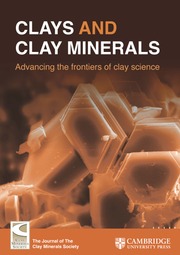Article contents
Effect of Photolytic Oxalate Treatment on Soil Hydroxy-Interlayered Vermiculites
Published online by Cambridge University Press: 01 July 2024
Abstract
The effects of Na-citrate-dithionite (NaCD), ammonium oxalate in the dark (NH4Ox-D), and photolytic reaction under ultraviolet radiation (NH4Ox-P) on the mineralogy of <2-µm fractions of selected soils from Virginia were investigated. The NH4Ox-D treatment removed the smallest amounts of Al (<0.22%) and Fe (<0.50%) from all soils, indicating low levels of noncrystalline material in these materials. From the six soils examined, NH4Ox-P treatment extracted 5–62% more Fe and 12–300% more Al than the NaCD treatment. The NH4Ox-D and NaCD treatments revealed no X-ray diffraction detectable alterations to mineral phases present in <2-µm fractions of these soils. The NH4Ox-P treatment, on the other hand, produced considerable degradation of hydroxy-interlayered vermiculites in these soils, as evidenced by a shift of the 14-Å X-ray diffraction maxima to lower spacings with heat treatment of the sample. The NH4Ox-P treatment removed variable amounts of hydroxy-Al material from the interlayers of 2:1 layer silicates, depending on their stability and degree of development.
Резюме
Исследовались эффекты Na-цитратного-дитионита (NaCD), оксалата аммония в темноте (NH4Ox-D) и фотолитическая реакция в ультрафиолетовом излучении (NH4Ox-P) на минералогию фракций размером <2 μм избранных почв Виргинии. Обработка NH4Ox-D удалила самые маленькие количества Аl (<0,22%) и Fe (<0,50%) из всех почв, указывая на низкий уровень некристаллического материала в этих почвах. Обработка NH4Ox-P удалила от 5 до 62% более Fe и от 12 до 300% более Аl, чем обработка NaCD из шести исследованных почв. После обработки NH4Ox-D и NaCD не было никаких измеряемых рентгеновской дифракцией фазовых перемен во фракциях этих почв размером <2 μм. Обработка NH4Ox-P, с другой стороны, вызвала значительную деградацию гидрокси-межслойных вермикулитов в этих почвах, на что указывал сдвиг 14 Å максимума рентгеновской дифракции в сторону меньших расстояний после тепловой обработки образца. Обработка NH4Ox-P удаляла разные количества гидрокси-Аl материала из прослоек 2:1 силикатов в зависимости от их стабильности и степени процесса образования. [Е.С.]
Resümee
Es wurden die Auswirkungen von Na-Citrat-Dithionit (NaCD), sowie die von Ammoniumoxalat im Dunkeln (NH4Ox-D) und bei der photolytischen Reaktion unter ultravioletter Bestrahlung (NH4Ox-P) auf die Mineralogie der Fraktion <2 μm von ausgewählten Böden aus Virginia untersucht. Die NH4Ox-D-Behandlung enttemte aus allen Böden die geringsten Mengen von Al (<0,22%) und Fe (<0,50%), was auf niedrige Gehalte an nichtkristallinem Material in diesen Substanzen hindeutet. Aus sechs untersuchten Böden extrahierte die NH4Ox-P-Behandlung 5-62% mehr Fe und 12–300% mehr Al als die NaCD-Behandlung. Die NH4Ox-D- und die NaCD-Behandlungen verursachten keine mit Röntgendiffraktion erkennbaren Veränderungen an den Mineralphasen in den Fraktionen <2 μm dieser Böden. Die NH4Ox-P- Behandlung verursachte dagegen in diesen Böden eine beachtliche Degradation der Vermiculite mit Hydroxy-Zwischenlagen, wie aus einer Verschiebung des 14 Å Maximums der Röntgendiffraktion nach kleineren Werten bei Erhitzen der Probe hervorging. Die NH4Ox-P-Behandlung entfernte unterschiedliche Mengen an Hydroxy-Al-Material aus den Zwischenschichten der 2:1 Schichtsilikate in Abhängigkeit von ihrer Stabilität und ihrem Kirstallisationsgrad. [U.W.]
Résumé
Les effets de la citrate-dithionite-Na (NaCD), ammonium oxalate, dans le noir (NH4Ox-D) et la réaction photolytique sous radiation ultraviolette (NH4Ox-P) sur la minéralogie de fractions <2-μm de sols sélectionnés de Virginie, ont été investigués. Le traitement au NH4Ox-D a enlevé les plus petites quantités d'Al (<0,22%) et de Fe (<0,50%) de tous les sols, indiquant de bas niveaux de matériel non-cristallin dans ces matériaux. Dans les six sols examinés, le traitement au NH4Ox-P a extrait de 5–62% plus de Fe et de 12–300% plus d'Al que le traitement au NH4Ox-D. Les traitements au NH4Ox-D et au NaCD n'ont révélé aucune altération détectible à la diffraction aux rayons-X des phases minérales présentes dans les fractions <2-μm dans ces sols. Le traitement au NH4Ox-P, d'un autre côté, a produit une dégradation considérable des vermiculites à intercouches hydroxy dans ces sols, mise en évidence par un déplacement des maxima 14 Å de la diffraction aux rayons-X à des espacements plus bas, avec traitement de l’échantillon à la chaleur. Le traitement NH4Ox-P a retiré des quantités variables de matériel Al-hydroxy des intercouches silicates à couches 2:1, dépendant de leur stabilité et de leur degré de développement. [D.J.]
Keywords
Information
- Type
- Research Article
- Information
- Copyright
- Copyright © 1981, The Clay Minerals Society
References
- 48
- Cited by

